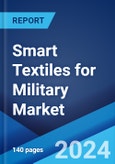Smart textiles for military refer to specialty fabrics that incorporate electronic components and technology that provides additional functionalities to soldiers beyond the traditional textile properties. They have integrated electronic components, such as sensors, microphone and cameras, to enhance their functionality and provide enhanced safety. These fabrics or materials are characterized by enhanced durability, flexibility and light weight. In addition, these textiles can have additional features, such as communication capabilities, and protection against external agents. The inbuilt sensors and cameras used in smart clothes provide communication between soldiers or between soldiers and command centers, monitor the wearer's vital signs and physical activity, and alert them if dangerous elements are nearby. Smart textiles for military also provide several advantages, such as the effective streamlining of various military functions simultaneously, saving time and resources, and increased soldier mobility due to the integration of multiple functionalities into a single piece of clothing or equipment.
Smart Textiles for Military Market Trends:
The global market is primarily driven by the augmenting demand for efficient textiles that can provide critical capabilities in the field while ensuring soldier safety. This can be attributed to the rising need for advanced military technologies with an enhanced focus on focus on soldier health and wellness. In line with this, the increasing adoption of lightweight and flexible smart textiles that can enhance soldier performance as well as comfort is also providing an impetus to the market. Moreover, the growing concerns regarding national security are resulting in continual upgradations in military gear, which, in turn, is resulting in an increased product demand. Continual technological developments in the manufacturing of various fabric materials and technologies for military applications, including conductive textiles, and nanotechnology, are also acting as another significant growth-inducing factor for the market. Besides this, considerable rise in investments from government agencies and defense organizations of several countries across the globe is also impacting the market positively. Furthermore, the increasing integration of the Internet of Things (IoT) technologies in smart textiles facilitating enhanced communication, situational awareness, and data analysis is also creating a positive outlook for the market. Some of the other factors contributing to the market include rapid digitization, rising geopolitical tensions, increasing military expenditure, and extensive research and development (R&D) activities conducted by the key players.Key Market Segmentation:
This report provides an analysis of the key trends in each segment of the global smart textiles for military market, along with forecasts at the global, regional, and country levels from 2025-2033. The report has categorized the market based on type, application and end user.Type Insights:
- Passive Smart Textiles
- Active Smart Textiles
- Ultra-Smart Textile
Application Insights:
- Health Monitoring and Diagnostics
- Energy Harvest
- Camouflage
- Temperature Monitoring and Control
- Protection and Mobility
End User Insights:
- Law Enforcement
- Defense
- Others
Regional Insights:
- North America
- United States
- Canada
- Europe
- Germany
- France
- United Kingdom
- Italy
- Spain
- Others
- Asia Pacific
- China
- Japan
- India
- South Korea
- Australia
- Indonesia
- Others
- Latin America
- Brazil
- Mexico
- Others
- Middle East and Africa
Competitive Landscape:
The report has also provided a comprehensive analysis of the competitive landscape in the global smart textiles for military market. Competitive analysis such as market structure, market share by key players, player positioning, top winning strategies, competitive dashboard, and company evaluation quadrant has been covered in the report. Also, detailed profiles of all major companies have been provided. Some of the companies covered include Advanced Fabric Technology LLC, Directa Plus SpA, Noble Biomaterials Inc., Outlast Technologies GmbH, Schoeller Textil AG, TenCate Protective Fabrics, WL Gore & Associates Inc. etc.Key Questions Answered in This Report
1. How big is the global smart textiles for military market?2. What is the expected growth rate of the global smart textiles for military market during 2025-2033?
3. What are the key factors driving the global smart textiles for military market?
4. What has been the impact of COVID-19 on the global smart textiles for military market?
5. What is the breakup of the global smart textiles for military market based on the type?
6. What is the breakup of the global smart textiles for military market based on the application?
7. What are the key regions in the global smart textiles for military market?
8. Who are the key players/companies in the global smart textiles for military market?
Table of Contents
Companies Mentioned
- Advanced Fabric Technology LLC
- Directa Plus SpA
- Noble Biomaterials Inc.
- Outlast Technologies GmbH
- Schoeller Textil AG
- TenCate Protective Fabrics
- WL Gore & Associates Inc.
Methodology

LOADING...








